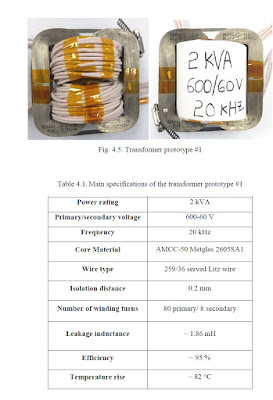domingo, 10 de dezembro de 2017
High-Frequency Transformer Design for Solid- State Transformers in Electric Power Distribution Systems Roderick Javier Garcia Montoya University of Arkansas, Fayetteville
High-Frequency Transformer Design for Solid-State Transformers in Electric Power Distribution Systems
ABSTRACT
A thesis submitted in partial fulfillment of the requirements for the degree of Master of Science in Electrical Engineering by Roderick Javier Garcia Montoya Universidad Tecnológica de Panamá Bachelor of Science in Electromechanical Engineering, 2011
December 2015 University of Arkansas This thesis is approved for recommendation to the Graduate Council. ABSTRACT The objective of this thesis is to present a high- or medium-frequency transformer design methodology for Solid-State Transformer (SST) applications. SSTs have been proposed as a replacement of the traditional 50/60 Hz transformer in applications demanding high-power density. Moreover, due to the high penetration of distributed generation, DC grids, energy storage systems, and sensitive loads, SSTs have been considered as an enabling technology for envisioned future energy systems. These applications demand additional functionalities that may not be achieved with traditional transformers. For example, active power flow control, harmonic suppression, voltage regulation, voltage sag compensation, and reduced size and volume. In this thesis, SST topologies are evaluated in order to determine their impact upon the transformer design. In addition, design considerations for core and wire selections, isolation requirements, and different transformer structures are investigated. As a result, the proposed transformer design methodology accounts for leakage inductance requirements for optimal power transfer, high-frequency effects in the transformer core and windings, and a flux density optimization to maximize transformer’s efficiency. The design procedure has been implemented in MATLAB® as an interactive tool for designing high-frequency transformers.
LINK
http://scholarworks.uark.edu/cgi/viewcontent.cgi?article=2381&context=etd
Assinar:
Postar comentários (Atom)




































 JOSIL ARTISTA PLASTICO FORTALEZA CEARA BRASIL AV.HERACLITO GRAÇA 41 TEL(85)32542378
JOSIL ARTISTA PLASTICO FORTALEZA CEARA BRASIL AV.HERACLITO GRAÇA 41 TEL(85)32542378
















Nenhum comentário:
Postar um comentário